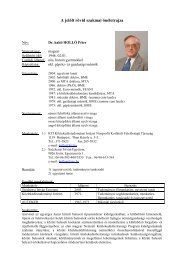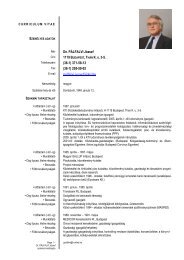VISION: Road Transport in Europe 2025 - FEHRL
VISION: Road Transport in Europe 2025 - FEHRL
VISION: Road Transport in Europe 2025 - FEHRL
Create successful ePaper yourself
Turn your PDF publications into a flip-book with our unique Google optimized e-Paper software.
user to make <strong>in</strong>formed decisions or at least understand the cause of any delays.<br />
It will be feasible for drivers and freight operators to book journey 'slots' as part of a multi-modally coord<strong>in</strong>ated<br />
total journey. This might <strong>in</strong>clude walk<strong>in</strong>g, car, bus, tra<strong>in</strong>.<br />
Data<br />
Taken as a whole, the data capture capability of the systems provid<strong>in</strong>g road-vehicle-driver l<strong>in</strong>kages will be<br />
extensive. This will range from data on the physical state of the roads themselves, through to the movements<br />
of <strong>in</strong>dividual drivers, their trajectories, and their environment. Such data, taken together, will provide an<br />
enormous step forward <strong>in</strong> our capability of manag<strong>in</strong>g traffic movement and the externalities that it generates.<br />
Data on traffic flows will enable journey times to be predicted with much greater accuracy. The availability of<br />
such data will enable operators to manage traffic flows and users to be advised of the optimum route to their<br />
dest<strong>in</strong>ation. There should be improved shar<strong>in</strong>g of <strong>in</strong>formation between modes allow<strong>in</strong>g better plann<strong>in</strong>g of<br />
<strong>in</strong>termodal travel and mak<strong>in</strong>g modal shift from the road more attractive. The ability to plan journeys <strong>in</strong><br />
advance and to obta<strong>in</strong> through-ticket<strong>in</strong>g between different modes will be particularly beneficial to the<br />
<strong>in</strong>creas<strong>in</strong>g number of elderly travellers.<br />
Controls and Restra<strong>in</strong>ts<br />
Most of the forego<strong>in</strong>g is about enablement: enabl<strong>in</strong>g free movement by provid<strong>in</strong>g road capacity or enhanc<strong>in</strong>g<br />
exist<strong>in</strong>g capacity, manag<strong>in</strong>g it better, and provid<strong>in</strong>g better <strong>in</strong>formation and options for users. But the new<br />
systems will also allow more sophisticated restra<strong>in</strong>t of <strong>in</strong>dividual actions contrary to the common good.These<br />
fall <strong>in</strong>to three broad categories: demand restra<strong>in</strong>t, risk restra<strong>in</strong>t, and environmental restra<strong>in</strong>t.<br />
The first, demand restra<strong>in</strong>t, sets out to limit the number of low value trips so as to reduce demand to match<br />
available capacity. This is most commonly conceived <strong>in</strong> f<strong>in</strong>ancial terms - as road pric<strong>in</strong>g or congestion pric<strong>in</strong>g<br />
or via deliberate capacity limitations, e.g. park<strong>in</strong>g restrictions. The new IT and communication systems l<strong>in</strong>ked<br />
to the roads <strong>in</strong>frastructure will <strong>in</strong> pr<strong>in</strong>ciple provide all the apparatus for charg<strong>in</strong>g users for their use of the road,<br />
if necessary as a function of the operat<strong>in</strong>g conditions at the time (for example if the road is heavily loaded or<br />
not) and a number of other factors. There are already a number of charg<strong>in</strong>g systems world-wide, although they<br />
are at present still very uncommon. Governments generally believe that if traffic growth cont<strong>in</strong>ues as<br />
expected some form of restra<strong>in</strong>t by charg<strong>in</strong>g is highly likely to be needed. By <strong>2025</strong> we expect charg<strong>in</strong>g with<strong>in</strong><br />
cities to be well established <strong>in</strong> Western <strong>Europe</strong> and probably more widely across <strong>Europe</strong> as a whole. The<br />
possible conditions and rules applied to such charg<strong>in</strong>g could vary widely. Inter-urban charg<strong>in</strong>g may also be<br />
<strong>in</strong> place, and this would help to balance transport costs between modes <strong>in</strong> the Government-Led scenario or to<br />
set the conditions of operation <strong>in</strong> the Market-Led scenario. Charges could be supplementary to exist<strong>in</strong>g fuel<br />
tax and vehicle charges through general taxation, or they could <strong>in</strong> some circumstances replace them. By <strong>2025</strong><br />
we expect vehicle recognition systems and f<strong>in</strong>ancial collection systems to be well established. How the<br />
revenues are used is considered later.<br />
33






